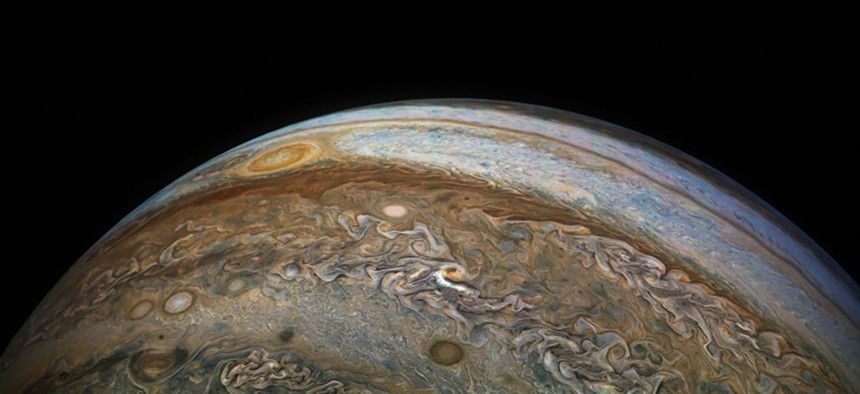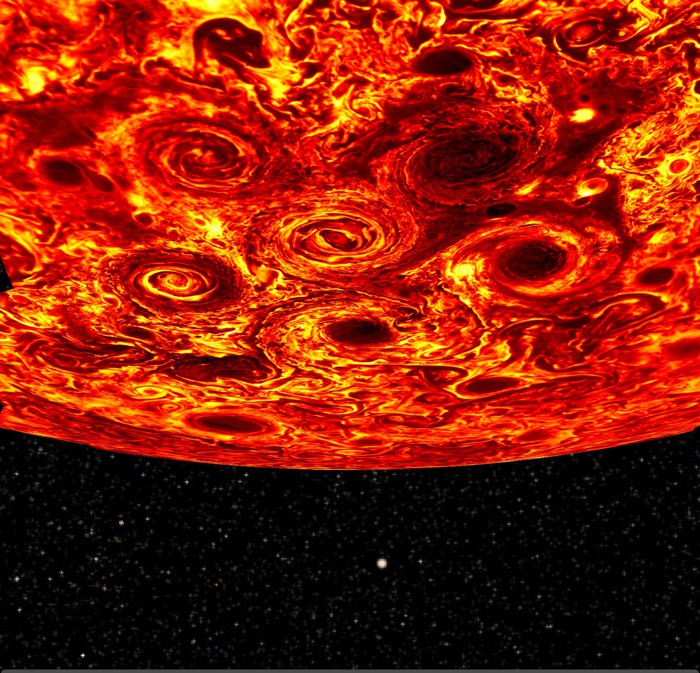
NASA / SwRI / MSSS / Gerald Eichstädt / Seán Doran
Jupiter Will Never Stop Surprising Scientists
NASA’s Juno mission keeps churning out stunning images of the gas planet’s clouds—and more mysteries about what lurks underneath.
For the last year and a half, the nasa spacecraft Juno has been circling Jupiter and collecting reams of data. Juno spends most of its time a good distance away from Jupiter, safe from the worst of the planet’s intense radiation belts. But once every orbit, the spacecraft comes swooping toward Jupiter and directs its instruments—protected by 400 pounds of titanium—toward the perpetually stormy clouds that cover its surface. Then it zooms back out.
One of those instruments, a camera called JunoCam, has produced dozens of mesmerizing photographs of Jupiter in extraordinary detail. The planet’s clouds, with their intricate eddies and swirls, look like something out of Van Gogh’s Starry Night.
Juno’s other instruments are designed to look deeper, beyond the beauty on the surface and into the darkness below. And the more they look, the more scientists learn that Jupiter is weirder than anyone thought.
“We’ve seen that a lot of our expectations were wrong,” says Scott Bolton, the principal investigator of the Juno mission and the director of space science and engineering at the Southwest Research Institute.
The Juno team’s first report of scientific results, released last May, shattered a number of predictions. The robust magnetic field that surrounds Jupiter, for example, is about twice as strong as models had predicted. Scientists had expected Jupiter to have either a dense core of heavy elements or no core at all, but Juno showed it’s probably something in the middle—a “fuzzy,” partially dissolved core—and much bigger than they anticipated.
Their newest report, released Wednesday and spread across several papers in the journal Nature, reveals even more surprises.
The winds at Jupiter’s surface, some of the most powerful in the solar system, influence the planet’s gravitational field, the latest observations show. This means that Jupiter’s signature, crisscrossing bands don’t just exist on the surface of the atmosphere. Jupiter’s wind flows actually extend 3,000 kilometers (about 1,860 miles) below the cloud tops, where the pressure is about 100,000 times that of the atmosphere at Earth’s surface.
Scientists now estimate Jupiter’s atmosphere makes up about 1 percent of the planet’s total mass. This may not seem like much, but consider that Jupiter is so big that more than 1,300 Earths could fit inside of it.
“None of the models predicted that it would go that deep,” Bolton said.
Below this depth, the data shows, Jupiter’s interior rotates as one solid body, a churning mass of liquid hydrogen and helium.
Other curious phenomena lie at Jupiter’s north and south poles. When Juno arrived at the planet, it revealed massive cyclones at the polar regions. Previously, scientists had seen a single, massive, hexagon-shaped storm brewing at one of Saturn’s poles, and expected to find something similar on Jupiter, since both are gas planets. But Jupiter’s polar storms have turned out to be completely different. There are multiple cyclones, and they’re arranged in a polygon shape. “Everybody’s scratching their heads,” says Fran Bagenal, a planetary space physicist at the University of Colorado who leads one of Juno’s science teams.
The spacecraft’s instruments have since observed the storms in visible and infrared wavelengths, and the imagery they’ve produced is beautiful. In infrared, the storms look like fiery bouquets of roses:

NASA / SWRI / JPL / ASI / INAF / IAPS
In this image, of Jupiter’s south pole, Juno is measuring the heat coming out of the depths of planet and through the clouds. Yellow indicates thinner clouds, and dark red means thicker ones.
Scientists don’t know what drives these cyclones—eight at the north pole, and five at the south—or how they stay intact without falling into each other. They don’t know how long they last; these storms may disappear in 10 years or continue churning for hundreds.
Such is the nature of studying Jupiter right now. The more surprises Juno reveals, the more mysteries arise. Scientists may have gained a clearer understanding of Jupiter’s winds, but they still don’t know what drives them. Even something as simple as what makes the clouds the colors they are—red, orange, beige, and blue—remains unknown.
Juno is only about one-third of the way through its mission, which is expected to end in 2021, unless congressional lawmakers approve funding for nasa to extend operations. By then, Juno, despite its armor, might sustain enough radiation from Jupiter to cause its instruments to degrade. If that happens, engineers will change Juno’s course and send it plunging into the planet, the same demise Cassini met last year after 13 years around Saturn.
Until then, Juno will continue on in its long orbit, diving toward Jupiter every now and then to get a good look. The encounters will produce more dreamy photographs of the planet’s stormy clouds, including its most famous, the Great Red Spot. But for Juno scientists, what’s hiding underneath is perhaps even more intriguing.
“The real question that we’re after is, how did it form?” Bolton said. “And what does that tell us about how the rest of the solar system formed and how other solar systems form? How are planets really made?”
Jupiter was likely the first planet to take shape in our solar system. It may have spent millions and millions of years wandering around the system and destroyed early generations of planets before settling into a peaceful orbit between Mars and Saturn. And much, much later, observations of Jupiter helped Galileo figure out that Earth wasn’t the center of the universe. To understand how Jupiter works would be to better understand the origins of our home in the cosmos.







